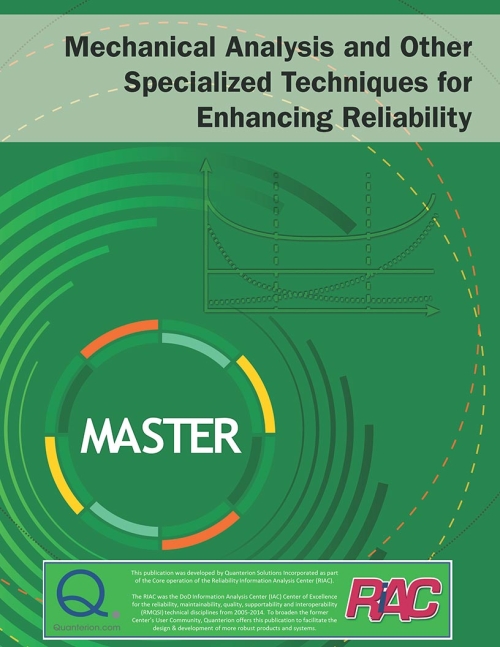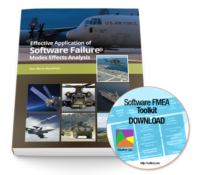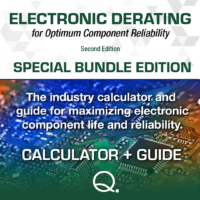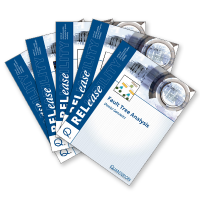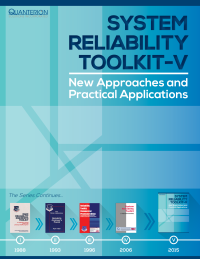| 1. Preliminary Reliability Concepts |
1 |
| 1.1. The Need for Reliability |
1 |
| 1.1.1. Customer Reliability Expectations |
3 |
| 1.1.2. Reliability as a Market Discriminator |
4 |
| 1.1.3. Related Reliability Issues |
6 |
| 1.1.4. Military and Commercial Reliability Needs |
11 |
| 1.2. Reliability and Maintainability Basics |
12 |
| 1.2.1. Reliability-Related Terminology |
12 |
| 1.2.2. The Bathtub Curve |
14 |
| 1.2.3. Reliability Metrics |
15 |
| 1.2.4. Availability |
18 |
| 2. The Nature of Mechanical Reliability |
21 |
| 2.1. Mechanical, Electronic, Software and Human Reliability |
21 |
| 2.1.1. Software Reliability vs Hardware Reliability |
21 |
| 2.1.2. Human Reliability vs Hardware Reliability |
24 |
| 2.1.3. Mechanical Reliability vs Electronic Reliability |
25 |
| 2.1.4. System and Part Reliability |
26 |
| 2.2. The Nature of Mechanical Failures |
28 |
| 2.2.1. Yielding |
28 |
| 2.2.2. Elastic Deformation |
29 |
| 2.2.3. Brinelling |
30 |
| 2.2.4. False Brinelling |
31 |
| 2.2.5. Fretting |
31 |
| 2.2.6. Brittle Fracture |
32 |
| 2.2.7. Ductile Fracture |
33 |
| 2.2.8. Buckling |
34 |
| 2.2.9. Creep |
35 |
| 2.2.10. Galling |
36 |
| 2.2.11. Spalling |
37 |
| 2.2.12. Wear |
38 |
| 2.2.13. Fatigue |
39 |
| 2.2.14. Uniform Corrosion |
42 |
| 2.2.15. Galvanic Corrosion |
44 |
| 2.2.16. Crevice Corrosion |
46 |
| 2.2.17. Pitting Corrosion |
47 |
| 2.2.18. Stress Corrosion Cracking |
48 |
| 2.2.19. Corrosion Fatigue |
50 |
| 2.2.20. Intergranular Corrosion |
51 |
| 2.2.21. Selective Leaching |
53 |
| 2.2.22. Erosion Corrosion |
53 |
| 2.2.23. Exfoliation |
55 |
| 2.2.24. Microbiologically Influenced Corrosion |
56 |
| 2.2.25. Filiform Corrosion |
57 |
| 2.2.26. Hydrogen Damage |
58 |
| 2.2.27. Hot Corrosion |
59 |
| 2.2.28. Radiation Damage |
60 |
| 2.2.29. Stress Relaxation |
60 |
| 2.2.30. Chemical Attack |
61 |
| 3. The Mechanical Reliability Process |
63 |
| 3.1. Preliminary Analyses |
66 |
| 3.1.1. Define System Functionality |
66 |
| 3.1.2. Reliability Requirements |
67 |
| 3.1.3. Design Data |
68 |
| 3.1.4. Environmental Characterization |
69 |
| 3.2. Devolve Design/Reliability Block Diagrams into Individual Parts |
69 |
| 3.2.1. Assemble Parts List |
70 |
| 3.2.2. Reliability Block Diagram |
70 |
| 4. Conduct System/Subsystem Analyses |
81 |
| 4.1. Collect Relevant Information |
81 |
| 4.1.1. Part Properties |
81 |
| 4.1.2. Reliability/Life Data |
81 |
| 4.2. Select the Appropriate Analysis Method |
82 |
| 4.3. Failure Modes and Effect Analysis |
83 |
| 4.3.1. Qualitative Failure Mode Severity Measures |
83 |
| 4.3.2. FMEA Report |
84 |
| 4.4. Failure Modes, Effects and Criticality Analysis (FMECA) |
86 |
| 4.4.1. Criticality Analysis |
86 |
| 4.4.2. FMECA Reports |
90 |
| 4.5. Performing an FMEA/FMECA |
92 |
| 4.6. Fault Tree Analysis (FTA) |
93 |
| 4.6.1. Intended Use of FTA Results |
93 |
| 4.6.2. FTA vs FMEA/FMECA |
94 |
| 4.6.3. FTA Construction |
95 |
| 4.6.4. Analyzing the Fault Tree |
99 |
| 4.6.5. FTA Examples |
104 |
| 4.7. “Back of the Envelope” Calculation |
107 |
| 4.8. Analyze System Reliability Analysis Results |
108 |
| 4.9. Construct List of Items Requiring Analysis |
108 |
| 4.10. Allocate Part Reliability Goals |
109 |
| 4.10.1. Reliability Allocation |
109 |
| 5. Part-Level Reliability Analyses |
119 |
| 5.1. Statistical Analysis Approach |
120 |
| 5.1.1. Evaluating and Ranking Data |
122 |
| 5.1.2. Selecting a Statistical Distribution |
127 |
| 5.1.3. The Weibull Analysis Process |
128 |
| 5.1.4. Distribution Analysis |
137 |
| 5.1.5. Select Alternate Plotting Paper for Poor Fit |
140 |
| 5.1.6. Performing Reliability Predictions |
144 |
| 5.2. Physics-of-Failure Modeling Approach |
152 |
| 5.2.1. PoF Reliability Prediction Process |
153 |
| 5.2.2. Applicable Models/Primary Failure Mechanisms |
158 |
| 5.2.3. Wear |
159 |
| 5.2.4. Creep |
184 |
| 5.2.5. Corrosion |
193 |
| 5.2.6. Summary and Recommendations |
205 |
| 5.3. Empirical Approaches to Reliability Predictions |
208 |
| 5.3.1. Determine Suitability of Empirical Approach |
209 |
| 5.3.2. Select Appropriate Statistical Distribution |
213 |
| 5.3.3. Surrogate Data Sources |
215 |
| 5.3.4. Empirical Mechanical Reliability Models |
235 |
| 5.3.5. NSWC Empirical Models |
235 |
| 5.4. Other Reliability Analysis Techniques |
317 |
| 5.4.1. Stress-Strength Interference |
318 |
| 5.4.2. Weibayes Analysis |
340 |
| 6. Evaluating, Tracking, Fielding and Improving Mechanical Equipment |
353 |
| 6.1. System Predictions |
353 |
| 6.1.1. Reliability Metrics |
354 |
| 6.1.2. System Modeling Approaches to Reliability Predictions |
355 |
| 6.1.3. System Reliability Using Cut-Sets |
359 |
| 6.1.4. Parts Count Reliability Prediction |
362 |
| 6.1.5. Alternative Approaches to System Reliability Predictions |
363 |
| 6.2. Reliability Testing Approaches |
363 |
| 6.2.1. Failure Discovery Testing |
364 |
| 6.2.2. Life Testing |
370 |
6.3. Tracking Reliability – Failure Reporting, Analysis and Corrective Action Systems
(FRACAS) |
375 |
| 6.4. Producing and Fielding the System |
378 |
| 6.4.1. Controlling Production Reliability |
379 |
| 6.4.2. Production Controls |
379 |
| 6.4.3. Reliability Screening |
379 |
| 6.4.4. Stress Screening |
381 |
| 6.4.5. Collect Field Data |
382 |
| 6.5. Reliability Growth |
383 |
| 6.5.1. Growth Throughout the System’s Life-cycle |
384 |
| 6.5.2. Reliability Growth Process |
387 |
| 6.5.3. Reliability Growth Management |
389 |
| 7. Mechanical Reliability Process Example |
393 |
| 7.1. Identify Part Modeling Techniques |
393 |
| 7.1.1. Collect Initial Data for System/Subsystem Failure Mode Analysis |
394 |
| 7.1.2. Conduct System/Subsystem Failure Mode Analysis |
397 |
| 7.1.3. Analyze Design Details and System Reliability Analysis Results |
407 |
| 7.1.4. Construct List of Items Requiring Analysis |
408 |
| 7.1.5. Allocate Part Reliability Goals from System Requirements |
409 |
| 7.1.6. Select Prediction Approach for Part Analysis |
409 |
| 7.2. Predict Part Reliability |
410 |
| 7.2.1. Example of Employing the Statistical Approach |
411 |
| 7.2.2. Example of Employing the Physics-of-Failure Approach |
415 |
| 7.2.3. Example of Employing the Empirical Approach |
421 |
| 7.2.4. Example of Employing the Stress-Strength Interference Approach |
423 |
| 7.3. Perform System Reliability Prediction |
427 |
| APPENDIX A: Environmental Characterization |
A-1 |
| A.1 Operational vs. Nonoperational Environments |
A-1 |
| A.1.1 Exposure to the External Environment |
A-4 |
| A.1.2 Micro-Environments |
A-8 |
| A.2 Environmental Factors |
A-9 |
| A.2.1 Temperature |
A-9 |
| A.2.2 Humidity |
A-11 |
| A.2.3 Radiation |
A-12 |
| A.2.4 Dust (Airborne and Ground) |
A-13 |
| A.2.5 Chemical Contaminants |
A-14 |
| A.2.6 Combined Effects |
A-15 |
| A.3 Environmental Loading Effects |
A-15 |
| A.4 Additional Considerations |
A-16 |
| A.5 Environmental Characterization Summary |
A-17 |
| APPENDIX B: Relevant Statistical Concepts |
B-1 |
| B.1 Probability Distributions |
B-4 |
| B.1.1 Binomial Distribution |
B-8 |
| B.1.2 Poisson Distribution |
B-9 |
| B.1.3 Normal Distribution |
B-11 |
| B.1.4 Exponential Distribution |
B-13 |
| B.1.5 Gamma Distribution |
B-14 |
| B.1.6 Weibull Distribution |
B-17 |
| B.2 Statistical Hypothesis Testing |
B-21 |
| B.2.1 Hypothesis Testing for Reliability Acceptance |
B-29 |
| B.2.2 Chi-Square Goodness-of-Fit |
B-33 |
| B.2.3 Kolmogorov-Smirnov Goodness-of-Fit Test |
B-35 |
| B.3 Parameter Estimation |
B-39 |
| B.4 Confidence Bounds |
B-43 |
| APPENDIX C: Reliability Data Sources |
C-1 |
| C.1 Test/Field Data |
C-1 |
| C.1.1 Failure Reports/Maintenance Logs |
C-1 |
| C.1.2 Failure Reporting, Analysis and Corrective Action System (FRACAS) |
C-2 |
| C.2 Surrogate Data |
C-3 |
| C.2.1 Legacy Part/System Data |
C-3 |
| C.2.2 Nonelectronic Parts Reliability Data (NPRD-2011) |
C-3 |
| C.2.3 Failure Mode/Mechanism Distributions (FMD-1997) |
C-4 |
| C.2.4 Offshore Reliability Data (OREDA) Handbook |
C-5 |
| C.2.5 U.S. Nuclear Regulatory Commission – Common Cause Failure Database |
C-6 |
| C.2.6 Other Reliability Data Sources |
C-7 |
| C.2.7 Electronic Part Failure Prediction |
C-7 |
| C.3 General Reliability Information |
C-8 |
| APPENDIX D: Weibull Library |
D-1 |


